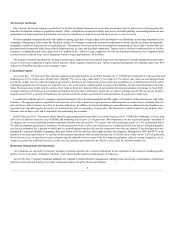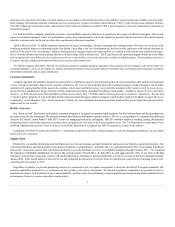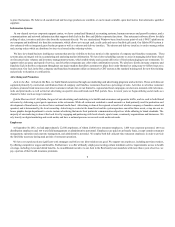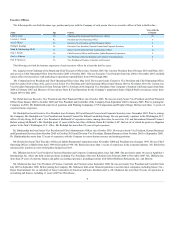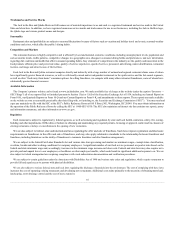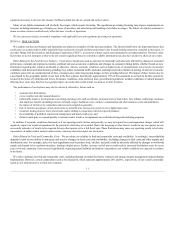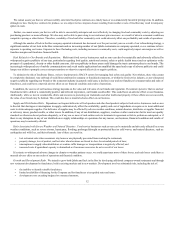Jack In The Box 2012 Annual Report Download - page 14
Download and view the complete annual report
Please find page 14 of the 2012 Jack In The Box annual report below. You can navigate through the pages in the report by either clicking on the pages listed below, or by using the keyword search tool below to find specific information within the annual report.
continuity plans that attempt to anticipate and mitigate such failures, but it is possible that significant capital investment could be required to rectify these
problems, or more likely that cash flows could be impacted, in the shorter term. Our security architecture is decentralized, such that payment card
information is primarily confined to the restaurant where the specific transaction took place. However, a security breach involving our point of sale, personnel,
franchise operations reporting or other systems could result in disclosure or theft of confidential customer or other data, loss of consumer confidence or
potential costs, fines and litigation, including costs associated with consumer fraud or privacy breach. These risks may be magnified by the increased use of
mobile communications and other new technologies, and are subject to increased and changing regulation. The costs of compliance, including increased
investment in technology or personnel in order to protect valuable business or consumer information, may negatively impact our margins.
Risks Related to the Failure of Internal Controls. We maintain a documented system of internal controls, which is reviewed and monitored by an
Internal Controls Committee and tested by the Company’s full-time internal audit department. The internal audit department reports to the Audit Committee of
the Board of Directors. We believe we have a well-designed system to maintain adequate internal controls on the business; however, we cannot be certain that
our controls will be adequate in the future or that adequate controls will be effective in preventing or detecting all error and all fraud. A control system, no
matter how well designed and operated, can provide only reasonable, not absolute, assurance that the control system’s objectives will be met. The design of
any system of controls is based in part on certain assumptions about the likelihood of future events, and there can be no assurance that any design will
succeed in achieving its stated goals under all potential future conditions. If our internal controls are ineffective, we may not be able to accurately report our
financial results or prevent fraud. Any failures in the effectiveness of our internal controls could have a material adverse effect on our operating results or cause
us to fail to meet reporting obligations.
Environmental and Land Risks and Regulations. We own or lease the real properties on which our Jack in the Box company-operated restaurants are
located, and either own or lease (and subsequently sublease to the franchisee) a majority of our Jack in the Box franchised restaurant sites. We lease the real
properties upon which our company-operated Qdoba restaurants are located. We have engaged and may engage in real estate development projects. As is the
case with any owner or operator of real property, we are subject to eminent domain proceedings that can impact the value of investments we have made in real
property. In addition, we are subject to a variety of federal, state and local governmental regulations relating to the use, storage, discharge, emission and
disposal of hazardous materials. Failure to comply with environmental laws could result in the imposition of severe penalties or restrictions on operations by
governmental agencies or courts of law, which could adversely affect operations. We are unaware of any significant hazards on properties we own or have
owned, or operate or have operated. Accordingly, we do not have environmental liability insurance for our restaurants, nor do we maintain a reserve to cover
such events. In the event of the determination of contamination on such properties, the Company, as owner or operator, could be held liable for severe penalties
and costs of remediation, and this could result in material liability.
Risks Related to Leverage. As of September 30, 2012, the Company had a credit facility comprised of a $400 million revolving credit facility and a
$165 million term loan. We could also request the issuance of up to $75.0 million in letters of credit. On November 5, 2012, we refinanced our existing
facility and entered into an amended and restated credit agreement consisting of a $400.0 million revolving credit facility and a $200.0 million term loan
facility. For additional information related to our new credit facility, refer to Note 21, Subsequent Events, of the notes to the consolidated financial statements.
Increased leverage resulting from borrowings under our credit facility could have certain material adverse effects on the Company, including but not limited to
the following:
•our ability to obtain additional financing in the future for acquisitions, working capital, capital expenditures and general corporate or other purposes
could be impaired, or any such financing may not be available on terms favorable to us;
•a substantial portion of our cash flows could be required for debt service and, as a result, might not be available for our operations or other
purposes;
•any substantial decrease in net operating cash flows or any substantial increase in expenses could make it difficult for us to meet our debt service
requirements or force us to modify our operations or sell assets;
•our ability to operate our business as well as our ability to repurchase stock or pay cash dividends to our stockholders may be restricted by the
financial and other covenants set forth in the credit facility;
•our ability to withstand competitive pressures may be decreased; and
•our level of indebtedness may make us more vulnerable to economic downturns and reduce our flexibility in responding to changing business,
regulatory and economic conditions.
Our ability to repay expected borrowings under our credit facility and to meet our other debt or contractual obligations (including compliance with
applicable financial covenants) will depend upon our future performance and our cash flows from operations, both of which are subject to prevailing
economic conditions and financial, business and other known and unknown risks and uncertainties, certain of which are beyond our control. In addition, to
the extent that banks in our revolving credit facility become insolvent, our ability to borrow to the full level of our facility could be limited.
15



